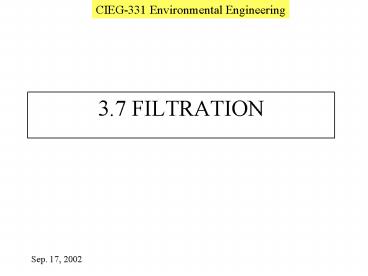3.7 FILTRATION - PowerPoint PPT Presentation
1 / 23
Title: 3.7 FILTRATION
1
3.7 FILTRATION
2
Regulatory requirements for filtration and
disinfection
- USEPAs (www.epa.gov) Surface Water Treatment
Rule - (SWTR), promulgated on June 29, 1989 (Federal
register - CFR Parts 140 and 141, 0. 27486-27568) requires
community - water systems to disinfect all surface water
and requires - filtration for most surface water sources.
- The supplementary information published with the
rule - presented recommended minimum levels of
disinfection to be - credited to the following defined filtration
processes - conventional filtration, direct filtration,
diatomaceous earth - filtration, and slow sand filtration
3
SWRT assumed Log removals and Turbidity
Requirements
From table IV-2 in supplementary information
p.27511 Special provision was made for slow
sand filters to exceed 1 ntu in some cases
providing effective disinfection was maintained
Conventional and direct filtration include
coagulation, flocculation, and in case
conventional filtration, sedimentation
4
- CLASSIFICATION OF FILTERS
- A number of different types of filters are used
in potable water treatment and they may be
described by various classification schemes - Based on the type of medium used
- granular bed filters - sand, coal (anthracite),
dual - media (sand coal), or mixed (coal,
sand, and garnet) - precoat filters - use very thin layer of very
fine medium - such as diatomaceous earth (DE)
- Based on loading rate slow sand filters, rapid
sand filters, or - high rate sand filters
- Based on hydraulic arrangements gravity filters
are open to - atmosphere pressure filters are pressure
driven - depth filtration if the solids are removed
within the granular - material (rapid granular bed filters) and cake
filtration if the - solids are removed on the entering face of
granular material - (precoat filters)
5
For instance gravity slow sand filters means a
filter open to atmosphere
filter loaded with sand
6
The vertical pressure filter system is applied
for all filtration applications with flow rates
of 2 MGD or less. Single or dual media beds are
available with gravel support bed or media
retaining underdrains.
7
- What the EPA says about slow sand filters"When
used with source water of the appropriate
quality, slow sand filtration may be the most
suitable filtration technology for small
systems." source Small Systems Compliance
Technology List For The Surface Water Treatment
Rule. USEPA, August 1997, Office of Water EPA
815-R-97-002, page 27
8
Process description
9
Types of Particle Capture
Brownian Diffusion (labelled A) Sedimentation or
Inertia (labelled B) Interception (labelled C)
Hydrodynamic (labelled D) Escaped Particle
(labelled as E)
10
(No Transcript)
11
(No Transcript)
12
(No Transcript)
13
Grain Size Characteristics
- The grain size analysis begin by placing the
sieve screens in ascending order with the largest
opening on top and the smallest opening on the
bottom. Then cumulative frequency distribution is
plotted - E - effective size
- U - uniformity coefficient
- Xg- geometric mean
- Sg - standard deviation
14
(No Transcript)
15
(No Transcript)
16
(No Transcript)
17
- Effective size
- E P10 0.3
- Uniformity coefficient
- U P60/P100.85/0.32.8
18
(No Transcript)
19
Backwashing
- is a routine procedure which is usually performed
on a weekly basis depending on what type of
filter is on your system. - When headloss through the filter reaches a set
value the filter is backwashed to remove the
accumulated solids - Filtered water is used for backwashing, which
consumes from 1 to 5 of the product
20
Headloss in expanded media
21
Requirements for Backwashing
- Head loss in expanded media
- hle(?s- ?)/ ?(1-ee)Le
- where ?s is density of medium particles
- ? is density of water
- ee is the porosity of the expanded medium
- Le id the depth of expanded media
- Le/L(1-e)/(1-ee)
22
- Backwash velocity
- the velocity to expand particles will vary as a
function of particle size - The suitable size to calculate the backwash
velocity is d90 - Remf(33.7)2(0.0408)Ga2-33.7
- Gad3 (?(?s- ?)g/?2
- Remf ?vmfd/ ?
23
(No Transcript)































